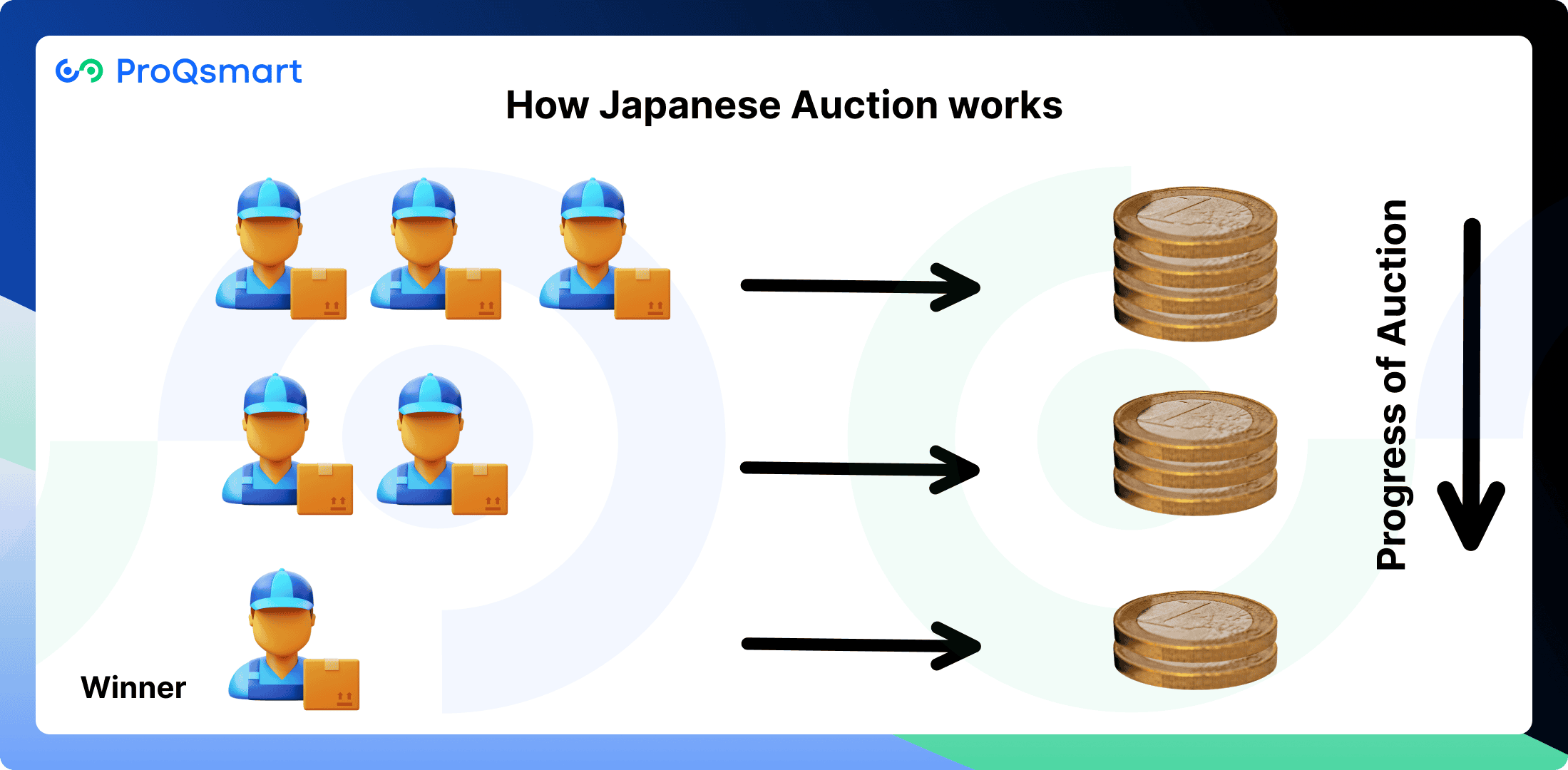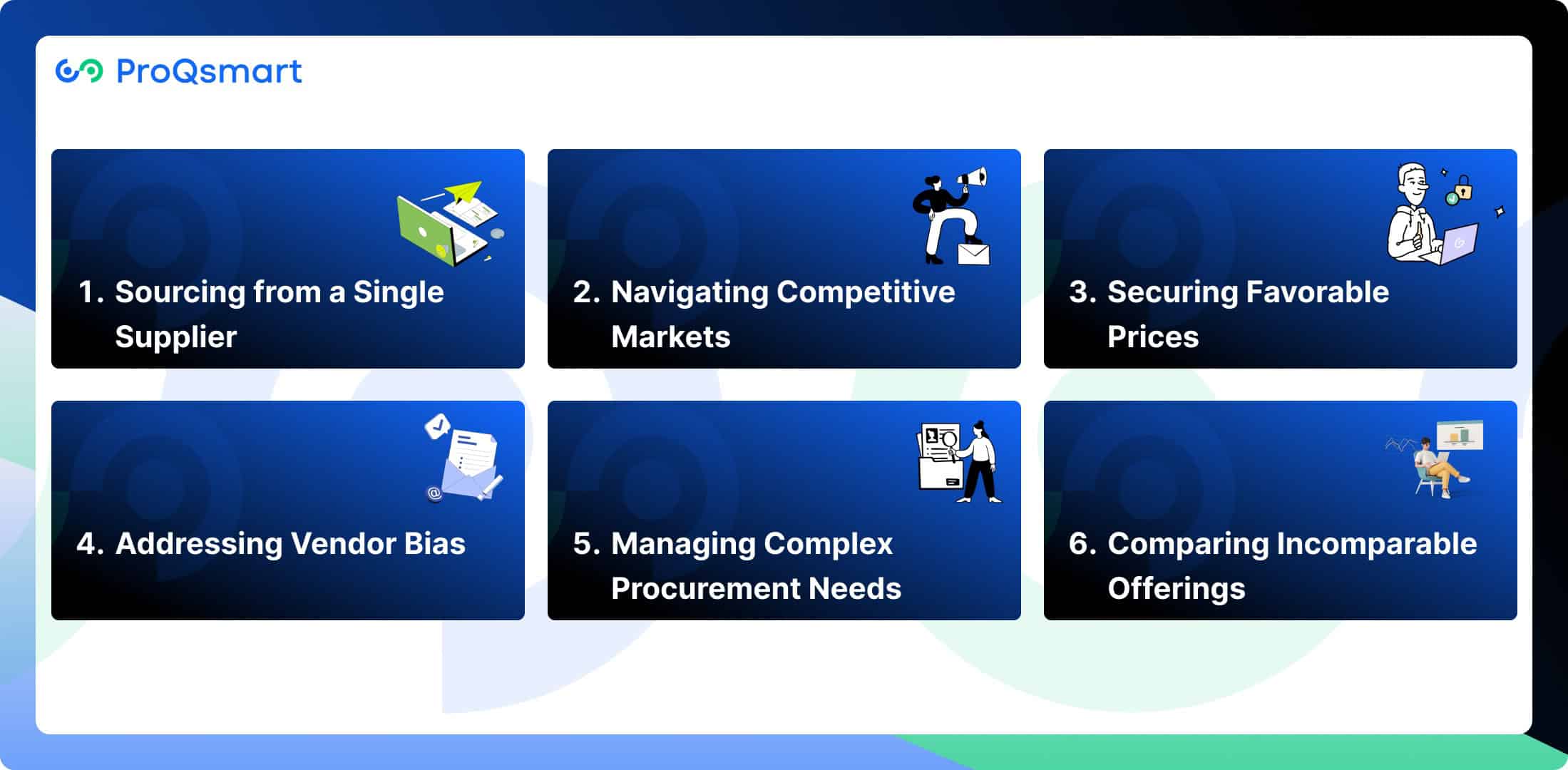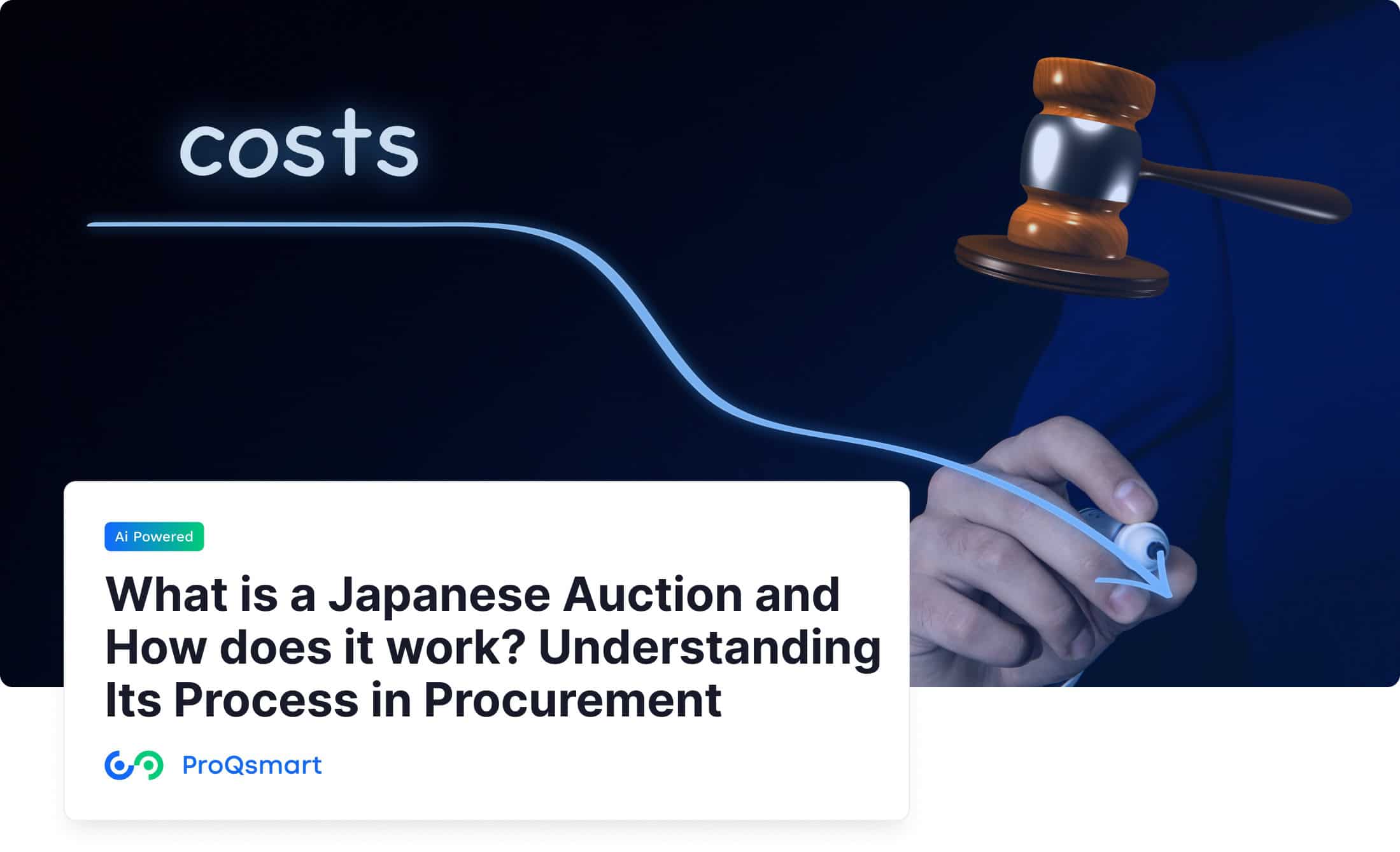Japanese auctions offer one of the most exciting and lucrative methods to purchase and sell items. In this auction, prices start at the maximum and go down until someone accepts the price. This approach is critical to the field of procurement, particularly as it grows in favor among sourcing strategies.
Learning about this unique auction style is incredibly important for procurement professionals. Japanese auctions are different from conventional auctions with rising bids. They push buyers and suppliers to develop speedy decision-making while still offering the benefits of open pricing.
The auction’s descending price mechanism ensures that buyers get the most competitive deals, while suppliers clear their inventory in the most efficient way. This auction format creates a new tactical advantage in negotiations, prompting proactive engagement and strategic planning from both sides.
What is a Japanese Auction?

A Japanese auction is a unique descending-price auction format where the starting price is set high and gradually decreases until a participant agrees to the current bid amount. This structure creates a strategic and competitive environment, distinguishing it from traditional auction types like English or Dutch auctions.
How Does a Japanese Auction Work?

In a Japanese auction, the auctioneer begins with a high starting price, which is systematically lowered until a supplier accepts the current bid. Suppliers can choose to walk away as prices decrease, fostering a competitive atmosphere. Unlike ascending-price auctions, where bidders publicly reveal their offers, the Japanese auction’s descending mechanism promotes transparency and fairness, allowing participants to bid true to their value. This format encourages strategic bidding, often leading to favorable outcomes for both buyers and sellers.
Key Features of Japanese Auctions
Descending Price Mechanism: Prices start high and decrease until a bid is accepted.
Transparency: Participants bid based on their true valuation, ensuring a fair process.
Low-Risk for Buyers: Buyers can wait for prices to drop to their desired level before committing.
Competitive Environment: Suppliers are motivated to act quickly, creating a dynamic bidding process.
The Process of a Japanese Auction
Initiation Setup
Japanese auctions start out with a predetermined, fixed starting price. This price results from supplier bids received during Requests for Information (RFIs) or Requests for Proposals (RFPs).
Here’s how you can set up a Japanese auction:
Set strong goals and prequalify bidders to maintain a serious auction atmosphere.
Market and context are key factors in determining the best setup for the auction.
Set clear rules and parameters ahead of time, and ensure that the process is open and transparent to keep it fair.
Plan a timeline down to the minute to ensure smooth activity flow and keep participants involved.
Market awareness and item selection are the most important aspects to cover in order to make sure you get off on the right foot. The efficacy of a Japanese auction is highly contingent on setting clear expectations and rules from the outset.
Bidding Dynamics
In Japanese Auctions, suppliers either accept the descending price or drop out as it decreases, with the last remaining supplier winning the contract. This “last supplier standing” approach ensures competitive pricing and transparency.
Bidding occurs in predefined increments, avoiding sudden price jumps and maintaining fairness. Suppliers strategically decide when to stay or exit, balancing profitability and competition. Technology enables real-time bidding and tracking, intensifying competition and influencing outcomes.
For buyers, this creates a transparent process to secure the lowest cost while fostering supplier competition, making Japanese Auctions a powerful tool for cost-effective procurement.
Finalization
The auction concludes when only one supplier remains, winning the contract at the final price. Post-auction, it’s critical to:
Communicate with all bidders to maintain transparency and preserve supplier relationships.
Finalize the contract with the winner, ensuring all terms, pricing, and deliverables are documented using procurement platforms or e-signature tools for accuracy and efficiency.
Archive auction data, including bidding history, supplier responses, and final outcomes, in a centralized system for future reference and audit purposes.
This structured approach strengthens the integrity of the procurement process and provides a reliable baseline for future negotiations and decision-making.
Japanese Auctions are a strategic procurement tool best utilized in the following scenarios:

Sourcing from a Single Supplier: When a buyer seeks a sole-source supplier for specialized or custom products, Japanese Auctions help secure the most competitive price.
Navigating Competitive Markets: In highly competitive markets, Japanese Auctions drive suppliers to offer their best rates, ensuring buyers achieve optimal pricing.
Securing Favorable Prices: For buyers aiming to obtain the most favorable prices across a range of products, Japanese Auctions create a competitive environment that pushes prices down.
Addressing Vendor Bias: When there’s a potential bias toward a specific vendor, Japanese Auctions introduce transparency and fairness, ensuring all suppliers compete on equal footing.
Managing Complex Procurement: Needs For procurement processes with varying or complex demands, Japanese Auctions simplify decision-making by focusing on price competitiveness.
Comparing Incomparable Offerings When products or services from vendors are difficult to compare, Japanese Auctions allow buyers to focus on price while still achieving value.
Benefits of Japanese Auction in Procurement
Cost Savings
One of the best benefits of Japanese auction in procurement is the cost savings that can be achieved by increasing competition among suppliers. When suppliers compete openly on this platform, buyers benefit from lower prices. This competitive environment drives suppliers to offer their most aggressive proposals.
This auction approach lowers the barrier to entry, allowing more participants to join and ultimately resulting in wider pricing competition. Businesses that have utilized Japanese auctions have saved as much as 90% in procurement costs. This demonstrates the long-term financial savings potential of this method.
This strategy is proven gold when it comes to locating single-source suppliers of highly specialized products. It truly empowers buyers to get the best bang for their buck.
Transparency
In Japanese auctions, transparency is an essential component in building trust and enhancing supplier relationships. Buyers benefit from greater transparency on supplier pricing strategies, which can inform future sourcing decisions.
The clear communication of auction rules and outcomes ensures that all participants are aware of bidding activities and results, enhancing supplier engagement. Technology enhances transparency, such as offering public visibility into the auction process.
This ultimately creates greater supplier confidence, leading to more competitive bids and improved collaboration.
Efficiency
The efficiency of Japanese auctions is unparalleled, providing a fast, simple procurement process that dramatically cuts administrative costs. Compared to other auction formats, this Japanese auction format mitigates risk by not disclosing competitor bids.
This approach accelerates decision-making, often supported by technology that ensures a fast and seamless bidding process and transaction management. Businesses have realized greater productivity measures.
Supplier Engagement
Early supplier engagement paired with clear communication improves and deepens supplier engagement and that’s a benefit of Japanese auctions. This competitive engagement helps build better relationships because in this form of procurement, suppliers know they need to better understand buyer needs to win the work.
Maintaining clear communication throughout the auction process increases supplier buy-in and participation. This results in a more inclusive, faster, and transparent decision-making process as well as successful procurement results.
Risk Management
Compared to other auction types, Japanese Auctions present less risk for buyers since they do not reveal competitor bids. This anonymity encourages suppliers to participate more freely without fear of underbidding themselves. Moreover, because suppliers are aware that they can opt out if prices become unfavorable, there is less pressure on them to submit unreasonably low bids that could compromise quality.
Challenges and Consideration
While there are many benefits, there are also challenges associated with Japanese auctions, particularly for bidders navigating the auction website.
Ethical Concerns: The lack of transparency can raise ethical issues regarding fair competition among suppliers. Ensuring that all participants understand the rules and expectations is crucial for maintaining integrity throughout the process.
Supplier Engagement: Educating suppliers about the auction format and its rules is essential for fostering participation. Many suppliers may be unfamiliar with this bidding style, which could impact their willingness to engage. Providing clear guidelines and support resources can help mitigate this issue.
Risk of Low Bids: There is a potential risk of “abnormally low bids,” which may affect project quality if suppliers cut corners to win contracts. Buyers should thoroughly evaluate proposals beyond just price by considering factors such as quality assurance processes and past performance metrics.
How to Implement Japanese Auction in Procurement Practices
Using Japanese auctions in procurement strategies provides a clear, methodical process to improve supplier selection and foster greater competition.
Here’s a bullet list of key steps for effectively implementing these auctions:
Start with an in-depth look at where you stand today with your procurement.
Align auction objectives with organizational goals to ensure relevance.
Select a user-friendly auction platform that supports accessibility.
Set clear auction parameters such as starting price, bid increments, and duration.
Communicate transparently with suppliers, detailing auction rules and expectations.
Monitor auction performance and evaluate outcomes against objectives.
Define Objectives
Setting objectives and being clear about them is the first step to take before starting a Japanese auction.
By articulating specific goals to direct the auction design and the selection of participants, the auctions have yielded demonstrable results. Typical goals are saving money, diversifying the supply chain, and improving procurement processes.
In previous auctions, bidders were focused on different goals. Some were just trying to realize a 10% cost savings, and others were trying to increase their supplier networks in a defined area.
Selecting an Auction Platform
Selecting the best auction platform depends on establishing the correct set of criteria, including user-friendliness and accessibility.
Tools such as real-time bidding and in-depth analytics add a new level of sophistication to the auction process.
Set Auction Parameters
Important parameters to set include initial price, bid increases, and length of auction.
These considerations have a major impact on auction dynamics. Flexibility to change parameters based on current market conditions is key.
Competitive auctions have included starting prices 5% lower than market rates and $0.50 bid increments to encourage competition.
Communicate Clearly with Suppliers
Suppliers that clearly understand auction rules and expectations are more likely to submit high-quality bids.
Strategies range from pre-auction briefings to robust instruction manuals. Regular feedback and training assistance are important factors in fostering strong supplier relations.
It’s worked past auctions are successful with frequent updates and timely answers to supplier questions.
Monitor and Evaluate
Monitoring auction performance is crucial.
Post auction, this should include monitoring participant engagement and evaluating auction outcomes against pre-defined objectives.
Best practices for data collection and analysis involve utilizing performance metrics and supplier feedback.
Feedback loops are instrumental in refining auction processes, keeping the mechanism in a state of constant improvement and increasing procurement efficiency over time.
Best Practices for Conducting Japanese Auctions
Buyers and sellers both succeed at Japanese auctions by adhering to these 7 best practices. At the center of these auctions is a granular knowledge of the process, particularly when using an auction website. Begin with a thoughtful review of where you are today, as this is incredibly useful for identifying achievable targets.
Preparation and planning go a long way in the auction arena. A robust market analysis to gauge what types of offers you might receive is critical, especially when considering the true value of items.
Here’s a bullet list of best practices:
Do a thorough self-analysis to understand where you’re at before you begin.
Prepare thoroughly with market research and pricing strategies.
Use trusted proxy bidders to maximize proper bidding.
Remain flexible, and be prepared to react to ongoing bids and auction developments.
Don’t forget other expenses, including auction fees and shipping, which can account for as much as 40% of the total cost.
What might sound like a recipe for chaos is actually the secret ingredient to successful, flexible auctions.
The Japanese reverse auction approach, where suppliers are only shown prices and the remaining time, requires speedy actions due to its peculiar nature.
We know buyers are better off this way, because it ensures they pay the lowest possible prices. Simultaneously, sellers benefit from a quick route to new contracts. Winning strategies usually include being attentive to the auction as it unfolds, comparing bids in real-time, and being willing to revise bids.
Examples are everywhere of cities getting better results by following these practices. Tactically, the marketplace creates valuable buyer transparency during the auction that often generates competitive pressure on bidders to increase their bids, increasing earnings for sellers.
Unparalleled efficiency is achieved through the ability to quickly compare varying types of offers to one another, making this auction type remarkably efficient.
Conclusion
As you explore the diverse landscape of e-auction types, Japanese auctions stand out as a compelling option for enhancing your procurement strategy. This auction format offers a streamlined bidding process, transparent pricing, and dynamic supplier engagement, all of which contribute to more efficient decision-making. By integrating Japanese auctions into your procurement practices, you can simplify processes and achieve significant savings while fostering stronger relationships with suppliers. Are you ready to elevate your procurement tactics? Consider incorporating Japanese auctions into your strategy and experience the benefits firsthand. Stay informed and empowered as you navigate the evolving world of public procurement.
Book a Demo with ProQsmart today to discover how you can leverage Japanese auctions and other e-auction formats to optimize your procurement outcomes!
FAQs
What is a Japanese Auction?
A Japanese auction is a fast-paced auction style where bidders bid up in increments, creating a competitive environment. This auction system is transparent, making it ideal for serious collectors and procurement environments.
How Does the Japanese Auction Process Work?
People begin bidding at a very low opening bid and continue to increase the bid until everyone else has dropped out in a Vickrey auction style. This Japanese auction method ensures that the last bidder standing wins, protecting against inflated pricing and promoting transparency.
When Should You Use a Japanese Auction?
Use it when you are interested in a fair, open, competitive bidding environment, such as a Vickrey auction, where transparency and market-based fair pricing is critical.
What Are the Benefits of Japanese Auctions?
They drive cost savings and foster supplier competition, ensuring that buyers in the auction arena get the most competitive rates through a truthful mechanism.
How Can ProQsmart Support Organizations Using Japanese Auctions?
While ProQsmart does not provide an auction website, it enhances procurement efficiency through tools that streamline supplier management and cost analysis, complementing auction strategies by improving transparency and decision-making in the bidding arena.



